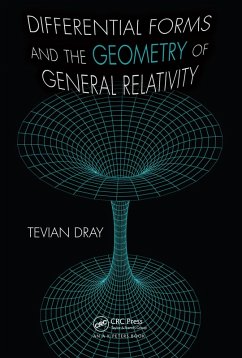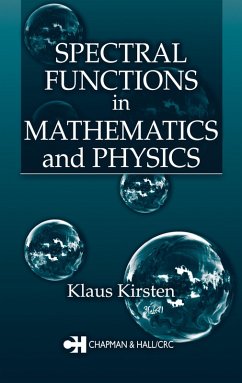
The Geometry of Special Relativity (eBook, ePUB)

PAYBACK Punkte
27 °P sammeln!
This unique book presents a particularly beautiful way of looking at special relativity. The author encourages students to see beyond the formulas to the deeper structure.The unification of space and time introduced by Einstein's special theory of relativity is one of the cornerstones of the modern scientific description of the universe. Yet the unification is counterintuitive because we perceive time very differently from space. Even in relativity, time is not just another dimension, it is one with different propertiesThe book treats the geometry of hyperbolas as the key to understanding spec...
This unique book presents a particularly beautiful way of looking at special relativity. The author encourages students to see beyond the formulas to the deeper structure.
The unification of space and time introduced by Einstein's special theory of relativity is one of the cornerstones of the modern scientific description of the universe. Yet the unification is counterintuitive because we perceive time very differently from space. Even in relativity, time is not just another dimension, it is one with different properties
The book treats the geometry of hyperbolas as the key to understanding special relativity. The author simplifies the formulas and emphasizes their geometric content. Many important relations, including the famous relativistic addition formula for velocities, then follow directly from the appropriate (hyperbolic) trigonometric addition formulas.
Prior mastery of (ordinary) trigonometry is sufficient for most of the material presented, although occasional use is made of elementary differential calculus, and the chapter on electromagnetism assumes some more advanced knowledge.
Changes to the Second Edition
Table of Contents
Preface
1. Introduction.
2. The Physics of Special Relativity.
3. Circle Geometry.
4. Hyperbola Geometry.
5. The Geometry of Special Relativity.
6. Applications.
7. Problems III.
8. Paradoxes.
9. Relativistic Mechanics.
10. Problems II.
11. Relativistic Electromagnetism.
12. Problems III.
13. Beyond Special Relativity.
14. Three-Dimensional Spacetime Diagrams.
15. Minkowski Area via Light Boxes.
16. Hyperbolic Geometry.
17. Calculus.
Bibliography.
Author Biography
Tevian Dray is a Professor of Mathematics at Oregon State University. His research lies at the interface between mathematics and physics, involving differential geometry and general relativity, as well as nonassociative algebra and particle physics; he also studies student understanding of "middle-division" mathematics and physics content. Educated at MIT and Berkeley, he held postdoctoral positions in both mathematics and physics in several countries prior to coming to OSU in 1988. Professor Dray is a Fellow of the American Physical Society for his work in relativity, and an award-winning teacher.
The unification of space and time introduced by Einstein's special theory of relativity is one of the cornerstones of the modern scientific description of the universe. Yet the unification is counterintuitive because we perceive time very differently from space. Even in relativity, time is not just another dimension, it is one with different properties
The book treats the geometry of hyperbolas as the key to understanding special relativity. The author simplifies the formulas and emphasizes their geometric content. Many important relations, including the famous relativistic addition formula for velocities, then follow directly from the appropriate (hyperbolic) trigonometric addition formulas.
Prior mastery of (ordinary) trigonometry is sufficient for most of the material presented, although occasional use is made of elementary differential calculus, and the chapter on electromagnetism assumes some more advanced knowledge.
Changes to the Second Edition
- The treatment of Minkowski space and spacetime diagrams has been expanded.
- Several new topics have been added, including a geometric derivation of Lorentz transformations, a discussion of three-dimensional spacetime diagrams, and a brief geometric description of "area" and how it can be used to measure time and distance.
- Minor notational changes were made to avoid conflict with existing usage
in the literature.
Table of Contents
Preface
1. Introduction.
2. The Physics of Special Relativity.
3. Circle Geometry.
4. Hyperbola Geometry.
5. The Geometry of Special Relativity.
6. Applications.
7. Problems III.
8. Paradoxes.
9. Relativistic Mechanics.
10. Problems II.
11. Relativistic Electromagnetism.
12. Problems III.
13. Beyond Special Relativity.
14. Three-Dimensional Spacetime Diagrams.
15. Minkowski Area via Light Boxes.
16. Hyperbolic Geometry.
17. Calculus.
Bibliography.
Author Biography
Tevian Dray is a Professor of Mathematics at Oregon State University. His research lies at the interface between mathematics and physics, involving differential geometry and general relativity, as well as nonassociative algebra and particle physics; he also studies student understanding of "middle-division" mathematics and physics content. Educated at MIT and Berkeley, he held postdoctoral positions in both mathematics and physics in several countries prior to coming to OSU in 1988. Professor Dray is a Fellow of the American Physical Society for his work in relativity, and an award-winning teacher.
Dieser Download kann aus rechtlichen Gründen nur mit Rechnungsadresse in A, B, BG, CY, CZ, D, DK, EW, E, FIN, F, GR, HR, H, IRL, I, LT, L, LR, M, NL, PL, P, R, S, SLO, SK ausgeliefert werden.













